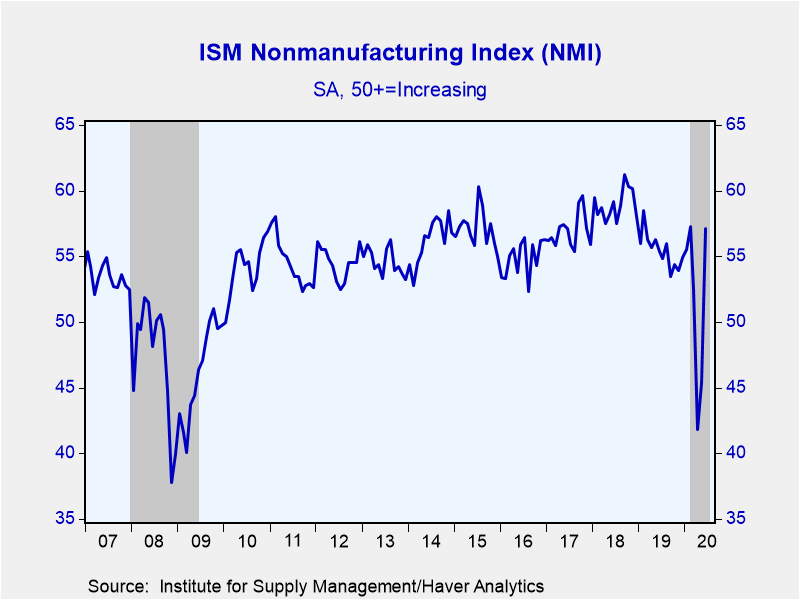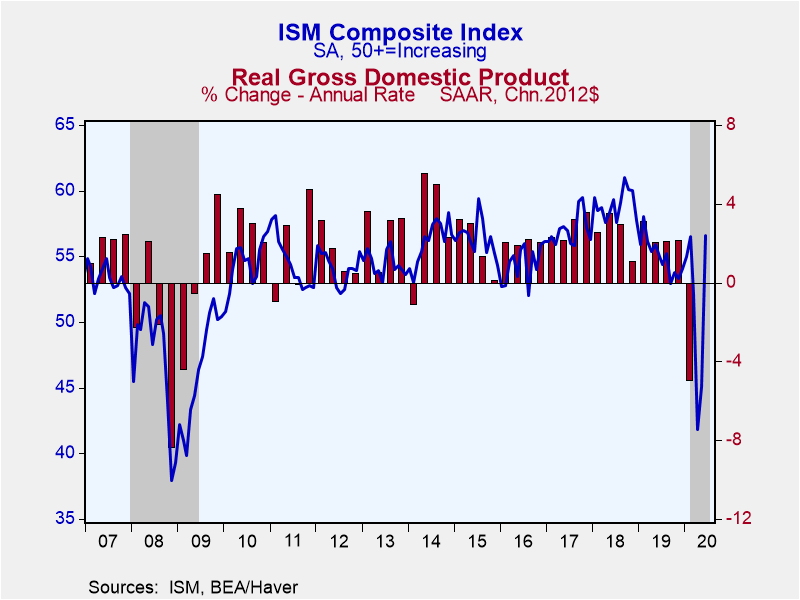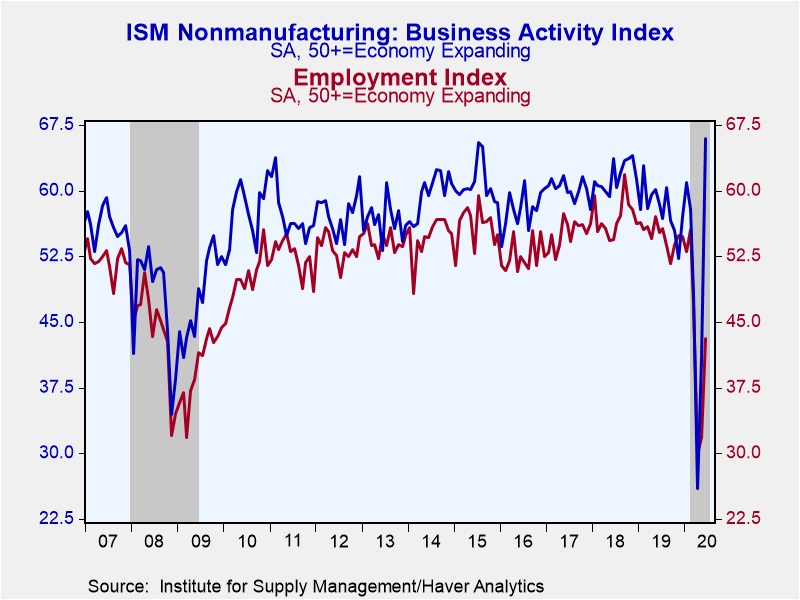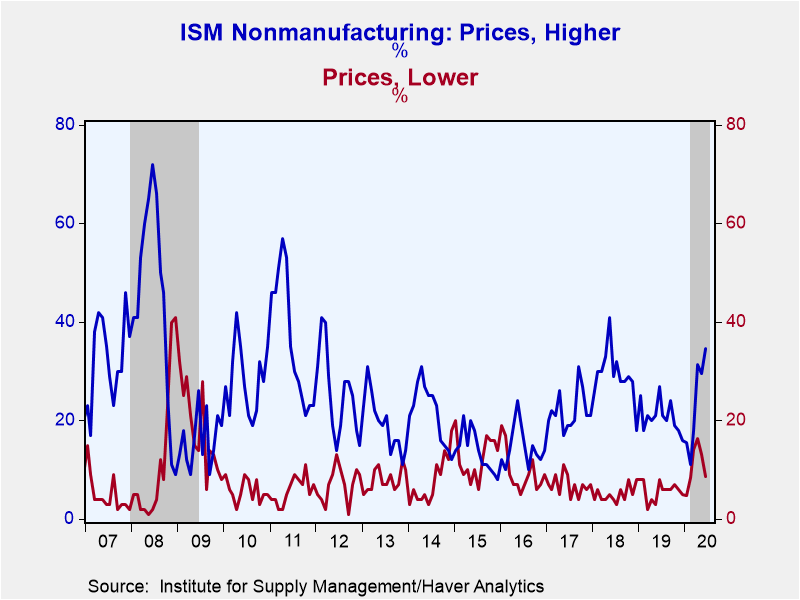 Global| Jul 06 2020
Global| Jul 06 2020U.S. ISM Nonmanufacturing Activity Index Unexpectedly Strengthens in June
by:Tom Moeller
|in:Economy in Brief
Summary
• Overall reading jumps to four-month high. • Business activity is pronounced. • Pricing power improves. Continued re-openings of businesses are reflected in the latest report from the Institute for Supply Management (ISM). The [...]
• Overall reading jumps to four-month high.
• Business activity is pronounced.
• Pricing power improves.
Continued re-openings of businesses are reflected in the latest report from the Institute for Supply Management (ISM). The Composite Index of Nonmanufacturing Business Activity increased to 57.1 during June after rising to 45.4 in May. It was the highest level since February. A reading of 49.3 had been expected in the Action Economics Forecast Survey.
Haver Analytics constructs a composite index combining the nonmanufacturing index and the manufacturing reading which was released last Wednesday. The composite index strengthened to 56.6, the highest level since February 2019. During the last 15 years, there has been a 63% correlation between the index level and the q/q change in real GDP. The composite is based on GDP shares.
The index of business activity surged to 66.0 last month and added to its May gain to 41.0. A strengthened 50% (NSA) of respondents reported improved activity while a greatly lessened 19% reported deterioration. The new orders index rebounded to 61.6 and added to its May improvement from April's record low of 32.9. The employment figure improved to a three-month high. An improved 16% of respondents reported increased hiring while a greatly lessened 25% reported less. The supplier delivery series offset these increases with a decline to 57.5 (NSA) as delivery speeds picked up.
The prices index increased to 62.4 from May's 55.6. Thirty-five percent of respondents reported higher prices, the most since May 2018, while a lessened nine percent reported lower. The percentage reporting no change in prices was little changed.
The export orders series surged to 58.9 after falling to a low of 36.3 in April and the imports index rose sharply to 52.9. The order backlogs index rose moderately. These series are not seasonally adjusted and are not included in the nonmanufacturing composite.
The ISM figures are available in Haver's USECON database, with additional detail in the SURVEYS database. The expectations figure from Action Economics is in the AS1REPNA database.
An Update to the Economic Outlook: 2020 to 2030 from the Congressional Budget Office can be found here.
| ISM Nonmanufacturing Survey (SA) | Jun | May | Apr | Jun'19 | 2019 | 2018 | 2017 |
|---|---|---|---|---|---|---|---|
| Composite Diffusion Index | 57.1 | 45.4 | 41.8 | 55.4 | 55.5 | 59.0 | 56.9 |
| Business Activity | 66.0 | 41.0 | 26.0 | 58.4 | 58.0 | 61.7 | 60.2 |
| New Orders | 61.6 | 41.9 | 32.9 | 56.6 | 57.5 | 61.4 | 59.3 |
| Employment | 43.1 | 31.8 | 30.0 | 55.2 | 54.9 | 56.9 | 55.1 |
| Supplier Deliveries (NSA) | 57.5 | 67.0 | 78.3 | 51.5 | 51.5 | 55.8 | 53.2 |
| Prices Index | 62.4 | 55.6 | 55.1 | 58.8 | 57.6 | 62.1 | 57.7 |
| ISM Manufacturing and Nonmanufacturing Composite | 56.6 | 45.1 | 41.8 | 55.0 | 55.0 | 59.0 | 57.0 |
Tom Moeller
AuthorMore in Author Profile »Prior to joining Haver Analytics in 2000, Mr. Moeller worked as the Economist at Chancellor Capital Management from 1985 to 1999. There, he developed comprehensive economic forecasts and interpreted economic data for equity and fixed income portfolio managers. Also at Chancellor, Mr. Moeller worked as an equity analyst and was responsible for researching and rating companies in the economically sensitive automobile and housing industries for investment in Chancellor’s equity portfolio. Prior to joining Chancellor, Mr. Moeller was an Economist at Citibank from 1979 to 1984. He also analyzed pricing behavior in the metals industry for the Council on Wage and Price Stability in Washington, D.C. In 1999, Mr. Moeller received the award for most accurate forecast from the Forecasters' Club of New York. From 1990 to 1992 he was President of the New York Association for Business Economists. Mr. Moeller earned an M.B.A. in Finance from Fordham University, where he graduated in 1987. He holds a Bachelor of Arts in Economics from George Washington University.










